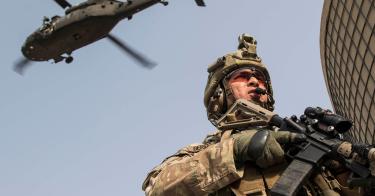No wonder the Biden administration chose to release their 2022 budget just before a long holiday weekend. It’s a common Washington practice for releasing news that officials hope will go unnoticed.
Biden’s defense budget offers little to improve any of the uniformed services, but it would absolutely devastate the readiness of the U.S. Army.
The Army’s 2022 budget needed to be $180 billion just to keep pace with inflation. The Biden budget offers only $173 billion, a loss of $7 billion in purchasing power.
It’s a budget calculated to take the Army back to the final years of the Obama administration, when readiness was miserable. After years of overuse and inadequate defense funding, Vice Chief Gen. Dan Allyn informed Congress in February 2016 that only three of the Army’s 58 brigade combat teams were fit to go to war.
>>> America Cannot Afford To Have the Defense Budget at the Same Levels
Biden’s budget would cut crucial combat training, curtail needed end-strength growth and slash equipment programs. If all of this were to go through, it would reduce soldiers and units to the poor readiness levels of 2016, if not worse.
No element of the Army escapes unscathed.
Training for brigade combat teams, the Army’s primary combat force, is cut by 30 percent. Army leadership tries hard to put a positive spin on this, stating they intend to focus training on lower echelons such as companies, instead of brigades, but the result will be inevitable—fewer units ready when the nation needs them.
Similarly combat training center rotations—the crown jewel in the Army’s training program—are cut from 26 in 2021 to 17 in 2022 (15 Regular Army and 2 National Guard). The Defender-series of joint exercises with NATO allies, which the Army considers to be a tremendous success, is slashed by $339 million. This will harm readiness and coordination among our European partners.
Not just training gets the ax. Most equipment programs are either put on life support or just cut outright. The Blackhawk, Apache, and Chinook helicopter modernization programs are all slashed, cut by at least a third. While most civilians probably wouldn’t opt to ride in an older model helicopter, it looks like soldiers won’t get that choice.
Procurement of key platforms like the armored Joint Light Tactical Vehicle, which replaces the unsurvivable HMMWV, are throttled way back to about 1,200 per year in 2022. At that anemic rate, the Army will need until 2055 to retire the HMMWV from its ranks. By then it will be 75 years old, the equivalent of driving the 1946 Willys CJ-2A jeep today.
The replacement for the venerable 1960s era M113 armored personnel carrier was supposed to be the Armored Multi-Purpose Vehicle. After years of fits and starts, it is finally ready for mass production, yet the Biden budget proposes buying none in 2022. For the foreseeable future, then, soldiers will be forced to operate a vehicle their grandfathers used in Vietnam.
>>> Three Big Questions Biden’s National Security Strategy Has To Answer
When he was Army chief of staff, Gen. Mark Milley frequently stated the Army was too small and the regular Army needed to grow to a size of at least 500,000. Many experts, including the bipartisan National Defense Strategy Commission (which included the current deputy secretary of defense and Pentagon comptroller) agreed, saying, “Simply put, the United States needs a larger force than it has today if it is to meet the objectives of the strategy.” But Biden’s budget puts all efforts to grow the military on hold. In fact, it proposes cutting the overall force by almost 5,000.
All these cuts stand in sharp contrast to the average increase of 16 percent that the Biden administration proposes for every federal department other than Defense and Homeland Security—the two departments responsible for America’s national security. How odd that those two should be targeted for what are effectively net decreases in spending.
America’s adversaries are rapidly increasing and modernizing their military capabilities. They are also doing their utmost to intimidate their neighbors: think Vladimir Putin in Ukraine and Xi Jinping in the South China Sea. Meanwhile, the Biden administration proposes dangerous cuts to military readiness.
This is no way to keep us safe. Fortunately, Congress will get the final word on this budget. Let’s hope they think it through better than the White House has.
This piece originally appeared in Sacramento Bee




